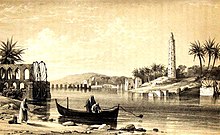Minaret of Anah
| Minaret of Anah Tower of Anah | |
|---|---|
Arabic: مئذنة عانة | |
 The minaret of Anah in 2013 | |
| Religion | |
| Affiliation | Islam |
| Province | Al Anbar Governorate |
| Ecclesiastical or organisational status | Minaret |
| Status | Reconstructed |
| Location | |
| Location | Anah, Iraq |
Location in Iraq | |
| Geographic coordinates | 34°22′08″N 42°00′34″E / 34.368988°N 42.009579°E |
| Architecture | |
| Type | Minaret |
| Style | Uqaylid |
| Founder | Uqaylid dynasty |
| Completed | 996-1096 CE |
| Destroyed | Destroyed twice in 2006 and then in 2016, but has since been rebuilt. |
| Specifications | |
| Minaret height | 28 metres (92 ft) |
| Materials | stone, gypsum |
The Minaret of Anah (Arabic: مئذنة عانة) or just Manaret al-Anah[1] is a historic free-standing minaret in Anah, Iraq. It was built during the late Abbasid period by a ruler of the Uqaylid dynasty.[1] The minaret has been destroyed twice in the modern era, but it has since been rebuilt.[2]
History

The minaret was built by one of the Uqaylid rulers. Experts have dated the construction of the minaret to between 996 CE to 1096 CE, with evidence from inscriptions and archeological features.[1]
In the mid-80s, the late president Saddam Hussein inaugurated several dams in the Euphrates river in order to secure the stable supply of water, affecting the region where the tower was located and resulted in the potential danger of the tower submerging into the water. A team of Iraqi archeological experts were able to figure out a plan to dismantle the minaret into at least 28 pieces, and put it back together at a nearby, less dangerous site.
Architecture
The minaret reaches the height of approximately 28 metres (92 ft) and consists of eight levels. On the northern side of the base of the minaret, one can access the minaret's interior through the opening entrance, and a staircase leads to a balcony.[1] The octagonal spire below the small dome topping the minaret has a total of 64 niches.[1] The minaret slightly leans on one end, but the tilt is not very prominent.
Destruction of the minaret
The Minaret of Anah has been destroyed twice, in 2006 and in 2016.
2006 destruction
The minaret suffered vandalism attacks in 2006.[3] It was then blown up completely by a still-unknown perpetrator. The explosion was considered among a series of events which targeted Iraqi cultural heritage sites, including the statue of Abu Ja’afar al-Mansur in Baghdad. The Iraqi Accord Front accused Shiite militias for deliberately destroying the cultural heritages built during the Sunni dynasties including the statue of al-Mansur and the top of the Great Mosque of Samarra's historic Malwiya Minaret.[4] Fortunately, the minaret was rebuilt in 2013, by the work of Iraqi engineers, artists and heritage conservation based on the preserved architectural blueprint from the Iraqi Ministry of Tourism.[3]
2016 destruction
The minaret of Anah was destroyed in late 2016 by the Islamic State of Iraq and the Levant[2] as part of an attempt to destroy cultural heritage in Iraq.[5]
Reconstruction
The minaret was eventually reconstructed in 2022, with efforts from Iraq's Ministry of Culture.[5] Several fragments from the ruined minaret were also sampled.[5] On the first of January 2023, further improvements and rehabilitation efforts were announced[2] such as extending electrical supply to the area and rebuilding the guardhouse.[2]
See also
- Islam in Iraq
- Imam Dur Mausoleum, another structure associated with the Uqaylid dynasty
References
- ^ a b c d e Manaret al-‘Anah. Archnet. Retrieved December 25, 2017.
- ^ a b c d "دائرة الصيانة والحفاظ على الآثار تعل عن أكمال تأهيل منارة عانة الاثرية". iraqpalm. Retrieved 2023-12-08.
- ^ a b السياحة والآثار تفتتح مئذنة "عنه" في الأنبار بعد ترميمها Archived 2018-02-22 at the Wayback Machine. Al-Mada Newspaper. Retrieved December 29, 2017.
- ^ 003. 'Anah — Minaret at 'Anah. Cultural Property Training Resource. Retrieved December 25, 2017.
- ^ a b c "Anbar is to commence reconstructing Minaret of Anah". Iraqi News Agency. Retrieved 2022-06-04.

